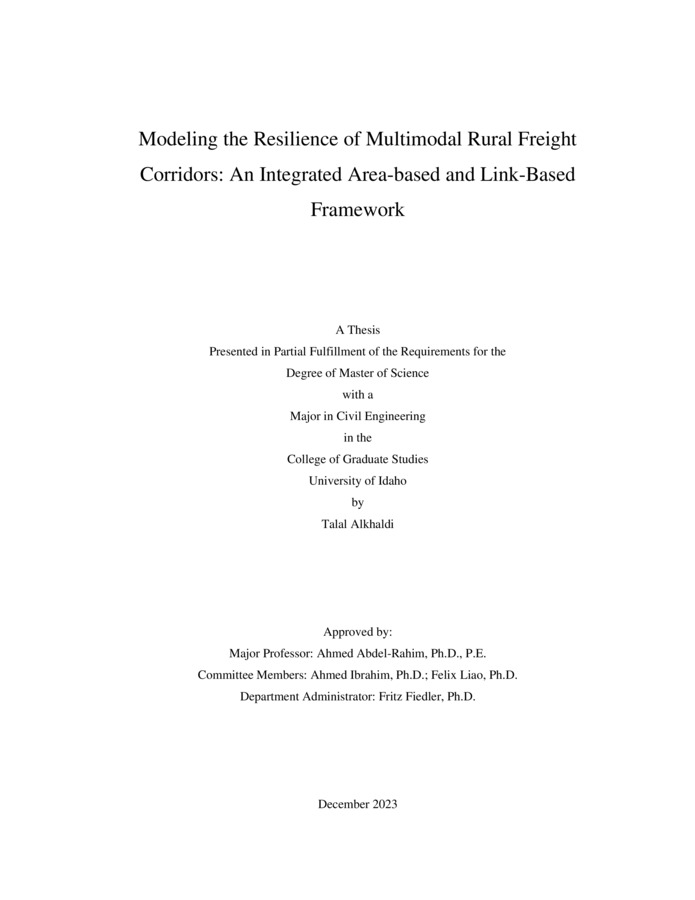Modeling the Resilience of Multimodal Rural Freight Corridors: An Integrated Area-based and Link-Based Framework
Alkhaldi, Talal. (2023-12). Modeling the Resilience of Multimodal Rural Freight Corridors: An Integrated Area-based and Link-Based Framework. Theses and Dissertations Collection, University of Idaho Library Digital Collections. https://www.lib.uidaho.edu/digital/etd/items/alkhaldi_idaho_0089n_12738.html
- Title:
- Modeling the Resilience of Multimodal Rural Freight Corridors: An Integrated Area-based and Link-Based Framework
- Author:
- Alkhaldi, Talal
- Date:
- 2023-12
- Program:
- Civil & Environmental Engr
- Subject Category:
- Civil engineering
- Abstract:
-
Resilience analysis for multimodal freight corridors involves assessing the ability of freight networks to sustain and robustly recover from disruptions such as natural disasters, accidents, or system failures. Such resiliency analysis should consider factors such as the risk of different disruptions, infrastructure health and robustness, and the redundancy of different network components. The primary focus of the research presented in this thesis is the resiliency of rural multimodal freight corridors that serve local industries such as agriculture, livestock, manufacturing, and mining. The research was conducted through several major tasks: a comprehensive literature review to synthesize the results of previous research; review of data available in the local, state, and federal levels to identify and document the availability of data as well as to highlight gaps that exist in this data; and the development of an integrated area-based and link-based framework to model the resiliency of multimodal rural freight corridors. Several disruptions are considered in this study including disruptions dure structural failure of one or more network element, disruptions due major crashes such as HAZMAT crashes on highway or railways, and disruptions due to natural hazards such as landslides, floods, and wildfires. While cyberattacks, such as ransomware attacks, can target ports and railway operations and cause considerable disruptions, they were not included in this research. Based on the review of data available for rural multimodal freight corridor analysis, several observations can be made: • While structural health data for bridges and culverts on the state highways are available and can easily be accessed, such data are either not available or difficult to access for all structures on the local highway system and for structures on railway lines. This causes a significant gap in the data needed to assess the structural failure risk indicators for major elements of the rural multimodal freight corridors, • Crash data for major crashes on the highway system are available and accessible from different sources. However, crashes and incidents on private railway lines are not publicly available, • Data for the risk indexes of different natural hazards is publicly available from federal sources at the county level. Few data are available in the more disaggregated route specific levels, and • Data on past disruption incidents to document details of the disruption, the response plan, and the recovery plans are either not available or hard to access. This data is valuable to document lessons learned from each disruption incident and to enhance coordination and communication among stakeholders to facilitate effective and prompt response and recovery efforts to future disruptions. The integrated link-based and area-based framework introduced in this research can be used to estimate structural failure risk indexes and HAZMAT/railway crash risk indexes for different links on the rural multimodal freight corridor networks. Additionally, at the link-based level, the redundancy and criticality index for each lick can be estimated. Area-based natural hazards data can be used to estimate the natural hazards risks indexes that are associated with each link in the network. The outcome of this integrated framework can assist transportation agencies in the following tasks: • Developing comprehensive risk management strategies that account for a wide range of potential disruptions and emergencies, • Use outcome the criticality and redundancy indexes for different network links to create redundancy and alternative options for freight movement, and • Establishing robust contingency plans and implementing data-driven decision-making processes to predict the likelihood of different disruptions and optimize response and recovery plans and operations.
- Description:
- masters, M.S., Civil & Environmental Engr -- University of Idaho - College of Graduate Studies, 2023-12
- Major Professor:
- Abdel-Rahim, Ahmed
- Committee:
- Ibrahim, Ahmed; Liao, Felix; Fiedler, Fritz
- Defense Date:
- 2023-12
- Identifier:
- Alkhaldi_idaho_0089N_12738
- Type:
- Text
- Format Original:
- Format:
- application/pdf
- Rights:
- In Copyright - Educational Use Permitted. For more information, please contact University of Idaho Library Special Collections and Archives Department at libspec@uidaho.edu.
- Standardized Rights:
- http://rightsstatements.org/vocab/InC-EDU/1.0/

